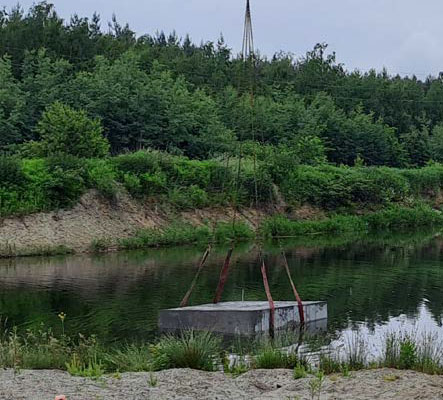Energy and Power Projects

Moor House - Wind Farm
- Cumbria, UK
- High Performance Concretes
Concretes with improved performance were required for a wind farm featuring an Anemometer mast, control building, access roads, crane pads and a temporary construction compound. Number of turbines: 6 (Tip height: 125m) Electricity generation capacity: 2MW per turbine. Up to c12MW in total. The concrete specification was pre-determined as C45-20GS3- P-DC2-B+wra (MCC 320, W/C 0.55). Concrete workability was set for the material to be pumped at an hourly rate of approx. 40m3 an hour. We supplied on 8 truck mixers via 2 plants) to achieve a daily volume of 300m3+. The £17.5 million renewable energy project will generate enough energy to power over 8,000 homes.

Concrete for Floating Islands
- Poland
- XF4 Without Air, High Performance Concretes
Pilot project to carry solar panels on water. Thin construction of 6 cm thickness from Resilia concrete is used without additional reinforcement to build the block. Benefits of that construction are a reduced material demand and weight of the construction and therefore a lower CO2 - footprint. The pilot island has been floating in one of our quarries since 2023 to observe its durability.
.jpg)
Cooling Tower
- Boxberg, Germany
- Acid Resistant Concrete
Construction was executed in 2007 to 2008 by slipform construction method. Concrete was delivery from a mobile mixing plant at the construction site. The concrete was specially designed for high attack by sulphuric acid with very low ph-values and proofed by MPA Berlin Brandenburg GmbH for its resistant above exposure class XA3. With that technology the costumer was able to avoid additional coating on the inside of the cooling tower.

Pumped Storage Power Plant
- Goldisthal, Germany
- High Performance Concretes
When there is a surplus of energy, water is pumped through pipes into a higher artificial storage basin. When the energy demand is high, the water is released again to generate additional electricity via turbines. Concrete was placed underground as mass concrete and stabilise the pipes inside the mountain. The material had to completely encase 6-diameter steel pipes and fill the entire cavity to the rock. Only a small amount of heat was allowed to be generated by concrete setting. In addition, the compressive concrete strength was expected as C35/45 to maintain operation in the event of complete pipe wear. The power plant has been in operation since 2003

Filling Sands with High Thermal Conductivity
- Germany
- Cable Sands & Cementitious Filling Material
Backfill sands for bedding electric cables have been developed in the laboratory, which are good at dissipating the heat from energy transport. The materials consist of natural sands and have been tested in the laboratory regarding their compactability, settlement behaviour, re-excavability and heat transport.
